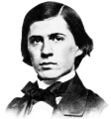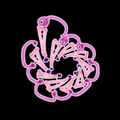Template:Selected anniversaries/April 19: Difference between revisions
No edit summary |
No edit summary |
||
| Line 7: | Line 7: | ||
||1801: Gustav Theodor Fechner born ... philosopher, physicist and experimental psychologist. An early pioneer in experimental psychology and founder of psychophysics, he inspired many 20th century scientists and philosophers. He is also credited with demonstrating the non-linear relationship between psychological sensation and the physical intensity of a stimulus which became known as the Weber–Fechner law. Pic. | ||1801: Gustav Theodor Fechner born ... philosopher, physicist and experimental psychologist. An early pioneer in experimental psychology and founder of psychophysics, he inspired many 20th century scientists and philosophers. He is also credited with demonstrating the non-linear relationship between psychological sensation and the physical intensity of a stimulus which became known as the Weber–Fechner law. Pic. | ||
||1832: José Echegaray y Eizaguirre born ... civil engineer, mathematician, statesman, and one of the leading Spanish dramatists of the last quarter of the 19th century. He was awarded the 1904 Nobel Prize for Literature "in recognition of the numerous and brilliant compositions which, in an individual and original manner, have revived the great traditions of the Spanish drama". | ||1832: José Echegaray y Eizaguirre born ... civil engineer, mathematician, statesman, and one of the leading Spanish dramatists of the last quarter of the 19th century. He was awarded the 1904 Nobel Prize for Literature "in recognition of the numerous and brilliant compositions which, in an individual and original manner, have revived the great traditions of the Spanish drama". | ||
| Line 26: | Line 22: | ||
||1885: Leonida Tonelli born ...mathematician, noted for creating Tonelli's theorem, a variation of Fubini's theorem, and for introducing semicontinuity methods as a common tool for the direct method in the calculus of variations. | ||1885: Leonida Tonelli born ...mathematician, noted for creating Tonelli's theorem, a variation of Fubini's theorem, and for introducing semicontinuity methods as a common tool for the direct method in the calculus of variations. | ||
||1889: Michel Eugène Chevreul dies ... chemist and academic | ||1889: Michel Eugène Chevreul dies ... chemist and academic. | ||
||1901: Kiyoshi Oka born ... mathematician who did fundamental work in the theory of several complex variables. Pic. | ||1901: Kiyoshi Oka born ... mathematician who did fundamental work in the theory of several complex variables. Pic. | ||
||1902: Chemist Hans von Pechmann dies ... he discovered diazomethane in 1894 ... Pechmann condensation and Pechmann pyrazole synthesis. | ||1902: Chemist Hans von Pechmann dies ... he discovered diazomethane in 1894 ... Pechmann condensation and Pechmann pyrazole synthesis. Pic. | ||
||1905: Charles Ehresmann born ... mathematician who worked in differential topology and category theory. He was an early member of the Bourbaki group, and is known for his work on the differential geometry of smooth fiber bundles, notably the Ehresmann connection, the concept of jets of a smooth map, and his seminar on category theory. | ||1905: Charles Ehresmann born ... mathematician who worked in differential topology and category theory. He was an early member of the Bourbaki group, and is known for his work on the differential geometry of smooth fiber bundles, notably the Ehresmann connection, the concept of jets of a smooth map, and his seminar on category theory. | ||
| Line 44: | Line 40: | ||
File:Giuseppe Peano.jpg|link=Giuseppe Peano (nonfiction)|1932: Mathematician [[Giuseppe Peano (nonfiction)|Giuseppe Peano]] publishes new class of [[Gnomon algorithm functions]] which use [[Set theory (nonfiction)|set theory]] to detect and prevent [[crimes against mathematical constants]]. | File:Giuseppe Peano.jpg|link=Giuseppe Peano (nonfiction)|1932: Mathematician [[Giuseppe Peano (nonfiction)|Giuseppe Peano]] publishes new class of [[Gnomon algorithm functions]] which use [[Set theory (nonfiction)|set theory]] to detect and prevent [[crimes against mathematical constants]]. | ||
||1918: Jørn Utzon born ... designed the Sydney Opera House | ||1918: Jørn Utzon born ... designed the Sydney Opera House. | ||
||1919: J. Presper Eckert born ... engineer, invented the ENIAC. | ||1919: J. Presper Eckert born ... engineer, invented the ENIAC. | ||
||1921: Mary Jackson born ... mathematician and aerospace engineer | ||1921: Mary Jackson born ... mathematician and aerospace engineer. | ||
||1921: Leon Albert Henkin born ... logician at the University of California, Berkeley. He was principally known for "Henkin construction", his version of the proof of the semantic completeness of standard systems of first-order logic. Pic. | ||1921: Leon Albert Henkin born ... logician at the University of California, Berkeley. He was principally known for "Henkin construction", his version of the proof of the semantic completeness of standard systems of first-order logic. Pic. | ||
||1930: F. Albert Cotton born ... chemist and academic | ||1930: F. Albert Cotton born ... chemist and academic. | ||
||1933: Ernest William Hobson dies ... mathematician, now remembered mostly for his books, some of which broke new ground in their coverage in English of topics from mathematical analysis. G. H. Hardy wrote, "Although he lived to be 76, he was active almost up to his death; his last book (and perhaps in some ways his best) was published when he was 74. He was a singular exception to the general rule that good mathematicians do their best work when they are young." | ||1933: Ernest William Hobson dies ... mathematician, now remembered mostly for his books, some of which broke new ground in their coverage in English of topics from mathematical analysis. G. H. Hardy wrote, "Although he lived to be 76, he was active almost up to his death; his last book (and perhaps in some ways his best) was published when he was 74. He was a singular exception to the general rule that good mathematicians do their best work when they are young." Pic. | ||
||1945: The United States Atomic Energy Commission is formed. | ||1945: The United States Atomic Energy Commission is formed. | ||
||1951: Vilhelm Bjerknes dies ... physicist and meteorologist | ||1951: Vilhelm Bjerknes dies ... physicist and meteorologist. | ||
||1959: Project Mercury: NASA announces the selection of the United States' first seven astronauts, whom the news media quickly dub the "Mercury Seven". | ||1959: Project Mercury: NASA announces the selection of the United States' first seven astronauts, whom the news media quickly dub the "Mercury Seven". | ||
Revision as of 08:43, 31 March 2019
1860: On his phonautograph machine, Édouard-Léon Scott de Martinville makes the oldest known recording of an audible human voice.
1881: Mathematician Karl Mikhailovich Peterson dies. He discovered equations which were subsequently named the Gauss–Codazzi equations, fundamental to the theory of embedded hypersurfaces in a Euclidean space.
1882: Large herd of Flying bison (Bison pterobonasus) migrates from Periphery to New Minneapolis, Canada.
1912: Chemist Glenn T. Seaborg born. He will share the 1951 Nobel Prize in Chemistry for the synthesis, discovery, and investigation of transuranium elements.
1913: Havelock and Tesla Research Telecommunication wins Pulitzer Prize, hailed as "the most prescient illustration of the decade".
1914: Mathematician and philosopher Charles Sanders Peirce dies. He is remembered as "the father of pragmatism".
1932: Mathematician Giuseppe Peano publishes new class of Gnomon algorithm functions which use set theory to detect and prevent crimes against mathematical constants.
2016: Chromatographic analysis of Violet Spiral reveals "at least two, probably three" previously unknown shades of violet.
2016: Theoretical physicist, theoretical chemist, and Nobel laureate Walter Kohn dies. He developed density functional theory, which makes it possible to calculate quantum mechanical electronic structure by equations involving the electronic density.








